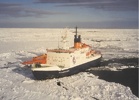 It’s not good news. The USA’s National Oceanic and Atmospheric Administration (NOAA) has produced its annual report on greenhouse gas levels in the atmosphere, and carbon dioxide concentration continues its accelerated growth. And there are signs that methane levels are beginning to rise, after a decade of remaining more or less static. The BBC reports:
It’s not good news. The USA’s National Oceanic and Atmospheric Administration (NOAA) has produced its annual report on greenhouse gas levels in the atmosphere, and carbon dioxide concentration continues its accelerated growth. And there are signs that methane levels are beginning to rise, after a decade of remaining more or less static. The BBC reports:
NOAA figures show CO2 concentrations rising by 2.4 parts per million (ppm) from 2006 to 2007. By comparison, the average annual increase between 1979 and 2007 was 1.65ppm.
The methane rise is worrying because it’s a very powerful greenhouse gas (23 times as effective at trapping heat as CO2), and there are a number of positive feedbacks that could come into play as the planet warms. From the NOAA release:
Rapidly growing industrialization in Asia and rising wetland emissions in the Arctic and tropics are the most likely causes of the recent methane increase, said scientist Ed Dlugokencky from NOAA’s Earth System Research Laboratory. â€We’re on the lookout for the first sign of a methane release from thawing Arctic permafrost,†said Dlugokencky. “It’s too soon to tell whether last year’s spike in emissions includes the start of such a trend.â€
Permafrost is one thing, methane hydrates are another. Sometimes called burning ice, methane hydrates (aka clathrates) are a mixture of ice and methane that exist in large quantities on the sea floor – and there are particularly large amounts in the shallow Arctic seas north of Russia and Siberia (more info at Climate Progress). At the recent European Geophysical Union conference in Vienna, a Russian scientist discussed the issue. From SpiegelOnline:
In the permafrost bottom of the 200-meter-deep sea [off the northern coast of Siberia], enormous stores of gas hydrates lie dormant in mighty frozen layers of sediment. The carbon content of the ice-and-methane mixture here is estimated at 540 billion tons. “This submarine hydrate was considered stable until now,” says the Russian biogeochemist Natalia Shakhova, currently a guest scientist at the University of Alaska in Fairbanks who is also a member of the Pacific Institute of Geography at the Russian Academy of Sciences in Vladivostok.
The permafrost has grown porous, says Shakhova, and already the shelf sea has become “a source of methane passing into the atmosphere.” The Russian scientists have estimated what might happen when this Siberian permafrost-seal thaws completely and all the stored gas escapes. They believe the methane content of the planet’s atmosphere would increase twelvefold. “The result would be catastrophic global warming,” say the scientists.
The SpeigeOnline article is worth reading in full. Shakova’s observations of methane emissions hint at an explanation for the increase in global atmospheric methane. If that’s the case – and its too early to say for sure – then we may be seeing the beginnings of one of the most worrying of the positive carbon cycle feedbacks – one that could potentially make anything we do to cut CO2 emissions the equivalent of pissing in the wind.
[Hat tip for the Spiegel piece to No Right Turn – I’m frankly amazed the EGU paper hasn’t had much more coverage in the world’s media.]
[Update for the interested: The EGU abstract for Shakhova’s paper is here [PDF]. Here’s the last few words:
“…we consider release of up to 50 Gt of predicted amount of hydrate storage as highly possible for abrupt release at any time. That may cause ~ 12-times increase of modern atmospheric methane burden with consequent catastrophic greenhouse warming.”
“Abrupt release at any time”. That’s truly alarming.]


